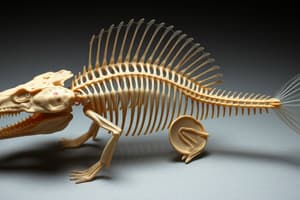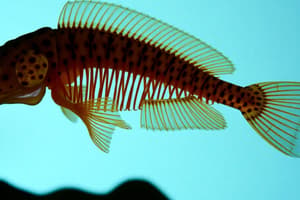Podcast
Questions and Answers
Which group of animals is NOT included under the phylum Chordata? (living)
Which group of animals is NOT included under the phylum Chordata? (living)
- Urochordates
- Cephalochordates
- Vertebrates
- Hemichordates (correct)
Why do we need to study chordates?
Why do we need to study chordates?
Humans belong to this phylum and many chordates have hard parts that yield a respectable history in the fossil record.
In terms of embryonic development, how do protostomes and deuterostomes differ in the fate of blastopore?
In terms of embryonic development, how do protostomes and deuterostomes differ in the fate of blastopore?
- Both protostomes and deuterostomes develop the mouth from the blastopore, but the process occurs at different stages.
- In protostomes, the blastopore becomes the mouth, while in deuterostomes, it becomes the anus. (correct)
- In protostomes, the blastopore becomes the anus, while in deuterostomes, it becomes the mouth.
- In both groups, the blastopore becomes the anus, but protostomes develop a secondary opening for the mouth.
Which of the following best describes the pattern of embryonic cleavage in protostomes compared to deuterostomes?
Which of the following best describes the pattern of embryonic cleavage in protostomes compared to deuterostomes?
Considering coelom formation, how does the process differ between protostomes and deuterostomes?
Considering coelom formation, how does the process differ between protostomes and deuterostomes?
Which of the following best contrasts the skeletal system of protostomes and deuterostomes?
Which of the following best contrasts the skeletal system of protostomes and deuterostomes?
What are the general characteristics of chordates?
What are the general characteristics of chordates?
Do the gills of fish and amphibians function the same as the pharyngeal slits? Why?
Do the gills of fish and amphibians function the same as the pharyngeal slits? Why?
Give two similarities of endostyle and thyroid gland.
Give two similarities of endostyle and thyroid gland.
Do all chordates have an endostyle/thyroid gland?
Do all chordates have an endostyle/thyroid gland?
Where is the dorsal hollow nerve cord derived?
Where is the dorsal hollow nerve cord derived?
Study Notes
Chordata Phylum Overview
- Hemichordates are not included in the phylum Chordata.
- Chordates share a common role in evolutionary studies due to their fossil records, which include hard parts.
- Humans are classified within the Chordata phylum.
Embryonic Development
- Protostomes: blastopore becomes the mouth.
- Deuterostomes: blastopore develops into the anus.
- Embryonic cleavage differs:
- Protostomes exhibit spiral and determinate cleavage.
- Deuterostomes show radial and indeterminate cleavage.
- Coelom formation differs:
- Protostomes: coelom forms by schizocoely (splitting of mesoderm).
- Deuterostomes: coelom forms via enterocoely (outpocketing of the archenteron).
Skeletal Systems
- Protostomes generally exhibit an ectodermal-derived exoskeleton.
- Deuterostomes typically possess a mesodermal-derived endoskeleton.
Key Characteristics of Chordates
- Notochord: flexible rod, hydrostatic organ, later replaced by vertebral column in many vertebrates.
- Pharyngeal slits: openings not solely used for respiration; serve in both feeding and early respiratory processes in primitive vertebrates.
- Endostyle/Thyroid gland: embryologically arises from the pharynx and plays a role in iodine metabolism.
- Dorsal tubular nerve cord: derived from ectoderm, central to the nervous system development in chordates.
Functional Differences in Pharyngeal Structures
- Gills in fish serve respiratory functions, while pharyngeal slits primarily supported feeding in early vertebrates.
- In fish and amphibians, pharyngeal slits may persist as water exit channels but do not contribute significantly to respiration.
Endostyle and Thyroid Gland
- Both structures arise from the floor of the pharynx and are involved in iodine metabolism.
- Various chordates possess either an endostyle or a developed thyroid gland at different life stages.
Dorsal Hollow Nerve Cord Origin
- Derived from ectoderm through a specific embryonic process of invagination, forming the central nervous system in chordates.
Studying That Suits You
Use AI to generate personalized quizzes and flashcards to suit your learning preferences.
Description
This quiz explores the key characteristics of the Chordata phylum, including their evolutionary significance and differences in embryonic development between protostomes and deuterostomes. Delve into the unique skeletal systems of these organisms and learn about the role of the notochord. Test your knowledge of chordate anatomy and development.




